Extremely popular among gardeners enjoy woing plants that are ideal for decorating walls of the house, arbors and terraces, as well as for fences and self-made supports and arches. Now the breeders have a lot of exotic and bright curly lien, landing and care for which are very difficult in our climatic conditions. Such capricious cultures include, for example, Clematis. However, in horticulture there are plants that differ in unpretentiousness and charming appearance.
Pay attention to Cali Salegia or Bindwee - a wing plant, which will very quickly grow up and covers a large territory. Multiplex Cali Salegia is one of the brightest and interesting varieties of this culture, which will become an excellent substitute for exotic plants.
In this article, consider the peculiarities of the appearance and the description of the Calistegia, as well as note the main points of landing and care for the Multiplex Cali Salegia.
Features and Description Cali Salegia Multiplex
Calistegia is a representative of herbaceous lien family binding. The natural area of \u200b\u200bthe habitat of this plant is the territory of East Asia, namely, Japan and China. There are wild species in the temperate climate of the Northern and South Hemisphere. In total, in nature, you can meet 25 species of Cali Salegia, among which decorative forms are particularly popular, such as Calistegia Makhrovka. The name of the plant went from two Greek words - "Cup" and "covering", which describes the appearance of the color of the Cali Salegia, having a large bract.
Many gardeners consider cissuegia weeding grass for very rapid growing and durable entry alongside growing plants. However, with proper care and fence of the root system of the Cali Salegia, you can get a beautiful flower. Multiplex Cali Salegia is a representative of terry species of culture that have greater decorativeness. With this plant, you can hide unsightly fences and fences, dilapidated gazebos and shabby walls. Judging by the reviews, Multiplex Caliistics is an unpretentious plant that can delight his lush flowering to the coldests. The only problem that can arise with you on the way to planting this culture is the complexity of the acquisition of Calistegia Multiplex seedlings, as they are quite rare in garden centers.
Multiplex Cali Salegia Description:
- Multiplex Cali Salegia is a representative of the type of terry caliperies.
- In its morphological features, this is a long-term grassy liana.
- The general genus of Calistegia has a number of other names that are pretty surprisingly characterized by this plant: dip, binding, birch, French rose or Siberian rose. It is the French rose that is called anchored Cali Salegia, to which the Multiplex variety belongs.
- This plant has a long and branched rhizome, which is very quickly sprawling. For the season you can detect new shoots about 1-1.5 m from maternal chest. It is for this feature that gardeners are often called Calustegia weed. However, if you protect the bottom of the rhizome, you will get a beautiful and decorative plant.
- Stem Cali Salegia Multiplex per season can grow to a height of up to 2-4 meters, while it is weak. In the fall of the stalks, the plants die off, so they are recommended to trim.
- Stems or vines are covered with red-brown bark.
- Cali Salegia Multiplex leaves have a triangular or heart-shaped form with clearly distinguishable residences. The top of the leaf is slightly pointed, and the edges of wavy. The top and bottom of the leaf plate have bright green.
- The leaves are attached to the stalk on long stiffs, while there are once.
- At the end of June or early July, the blossom of Calistegia Multiplex begins, provided that the plant is planted in a sunny place. In the shady spot, bloom will begin a little later - in about august.
- The flowering lasts to the most frosts, while the entire stem is thickly covered with beautiful flowers that bloom from each sinus.
- The flowers of this variety are terry, in diameter can reach approximately 8-9 cm. Consist of a large number of petals with a wavy edge surrounding the core in the form of a column. For your appearance, this variety in the people is called the French rose.
- Multiplex gentle pink calishek colors coloring.
- This plant grade does not give seeds, so only vegetatively breeds.
- Multiplex Cali Salegia is distinguished by excellent frost resistance, but with sufficiently severe winter it requires a small shelter.
- The plant is considered a long-liver, as in one place can grow perfectly up to 10 years.
Multiplex Cali Salegia Reproduction: The most common ways
Cali Salegia Multiplex, like other decorative terry varieties, does not give seed after biting inflorescences, therefore the only possible way to breed such a plant is vegetative reproduction. Most often, gardeners try to destroy the new shoots of this culture, since the rate of the growth of the CaliShelia simply amazes. However, such decorative varieties like a multiplex will definitely not spoil your landscape design, but will make it brighter and original.
Reproduction of Cali Salegia Multiplex root process
- For the season, one plant of Cali Salegia Multiplex gives a huge number of processes that appear from the scared rhizoma.
- In the fall at a distance of about 1.5 m from the mother's cookistic, you can see young shoots-processes - it is them that can be used to breed a plant.
- It is necessary to take a sharp shovel and carefully dig up a young escape along with part of the root and soil.
- Immediately need to prepare a place under the landing of a young plant. To do this, dig up the landing fossa and place the sapling there. After that, sprinkle the soil.
- A planted plant is recommended to hide abundantly.
- Since shooting shoots appear in autumn, the reproduction also occurs in the fall. Therefore, planted seedlings are best covered by winter sawdust or fallen foliage.
Calushegia multiplex multiplex rhizomic division
- This method of reproduction of Cali Salegia Multiplex is very similar to the previous one, only in this case it is necessary to plant a small piece of the rhizoma of the plant.
- In this case, a full-fledged seedling can grow from one small piece of the root of Calistegia, since the rhizome of this plant has very good regenerative abilities.
- In the fall, after a bunch of inflorescences of grassy lianas, you need to separate part of the root along with the soil and put it in a cool place.
- Separate the best acute shovel.
- Drawing the rhizome in the wooden box and put in a dark and cool room, for example, a basement.
- During storage, it is important to periodically water the earth to periodically so that it is always a little moistened.
- Somewhere in early March, remove your rhizome from the basement and completely clean it from the ground.
- Next to the sharp knife, cut the root into a large number of small parts, the length of which should be no more than 5-7 cm.
- Gardeners necessarily recommend cutting places to handle with crowded charcoal for faster healing.
- Next, prepare peat pots and put the prepared pieces of rhizomes in them. At the same time, it is necessary to plunge about 3-5 cm.
- Be sure after the landing abundantly, your future seedlings.
- When the seedlings in height reach approximately 5 cm, it is necessary to pinch them, so as not to give the shoots strongly pull into the height, but allowing you to go.
- In mid-May, you can land your young shoots to a permanent place in the garden.
Preparation before planting Cali Salegia Multiplex
Multiplex Cali Salegia is an unpretentious plant and perfectly carries out in any garden and on any plot. However, in Russia, this is still an unusual plant, which is quite rarely found as a decorative element of landscape design that is why it is important for the landing of Calushegia to carefully prepare and think over all the stages to the smallest details: from buying high-quality seedlings to choose the most optimal place for landing the Multiplex Cali Salegia.
Stage 1. Selection and preparation of landing material Cali Salegia Multiplex
- Buy Multiplex Cali Salegia is quite problematic in our country, since this variety is still a wonder.
- If you want to search this plant on sale, give preference to large garden centers and nurseries, where they are professionally engaged in breeding various plants.
- In specialized stores, you can immediately purchase a seedlock ready for disembarking.
- You can also find an adult plant from your acquaintances, if that is, and ask a piece of rhizomes for breeding.
- If you buy a seedling in the nursery, check all the moments of growing plants, landing and care.
- Before buying, carefully inspect the seedling. It should not be visible damage and signs of disease. If the seedling is purchased in a peat pot, the soil must be clean and wet.
- Never go on the scams who can offer you the seeds of Cali Salegia Multiplex, this plant divorces only vegetatively.
Stage 2. Choosing a place for landing of Cali Salegia Multiplex
- Cali Salegia Multiplex feels great in sunny sites, where it begins to bloom in June and fully pleases the beauty of its colors.
- If you put this plant in the shade, bloom will be less lush.
- Also preferred the place where the groundwater is sufficiently deeply, the CaliShegia does not carry out the stagnation of moisture from the roots.
- It is not recommended to plant castellage multiplex near flower beds, flower beds, near decorative shrubs. This herbian liana can suppress any plant growing nearby.
- It is best to plant seedlings of this culture along the walls of the house or a barn, along the fence and fence, near the arbors and terraces where there are no decorative plants.
- If you are planning to land the Cali Salegia away from natural supports, it must be built at the time of plant planning, as this Liana is very quickly released shoots. As a support, you can fix the Raubits mesh, rope, arch.
- If you choose to kalistegii multiplex ideal place, it will delight you with beautiful blooms more than 10 years.
Step 3: Choosing and preparing the ground for planting kalistegii multiplex
- Kalistegiya multiplex can grow in any soil, but especially beautiful plant blooms in light lands.
- Choose a place on your site with a fairly light soil, it is also desirable that the soil nutrient.
- The ideal composition is loamy, peaty or leafy soil. Such soils have optimal looseness, which is very important for growing kalistegii multiplex.
- It is important to well prepare the ground for planting. To do this, somewhere in May, it is necessary to dig the selected location about 25-30 cm deep. When processing is required to add to the soil humus and a little bucket of complex mineral fertilizers, as kalistegiya multiplex quite a powerful vine, which gives a large number of colors. Therefore, it needs a lot of nutrients.
- Advance can think about the support for which will cling creeper. To do this, use a regular string that is stretched vertically to vine pulling up.
planting technology kalistegii multiplex
- The best time for planting kalistegii multiplex in open ground it is spring or autumn. Although it is best to give preference to spring planting, because your vine will have time to put a large number of shoots and bloom in autumn.
- For planting seedlings can use ready-made, purchased or grown on their own roots of the vines.
- Part of the rhizomes can be planted directly into the ground.
- Prepare soil mixture before the landing. To do this, you can take the turf ground, humus and sand and mix them. You can add a little wood ash or dolomite. After that, dig a planting hole, and the earth out of it aside.
- Gardeners recommend limiting root kalistegii multiplex to it from growing over a wide area. For this purpose a plant hole to a depth of 25-30 cm spread on the walls of slate, plastic mesh or tape. Alternatively, you can use any fairly large container without a bottom. This will limit the space for the growth of rhizomes creepers.
- Planting seedlings kalistegii must be at a distance of 30-35 cm.
- At the bottom of the landing pit can be placed layer of drainage, as this plant does not tolerate water stagnation and the proximity of groundwater. As the drainage can be used small stones and gravel.
- Next, place the seedling of the Cali Salegia multiplex on the bottom of the landing pit, spread the roots and sprinkle the harvested soil mixture.
- After landing, Liana seedlings are important to hide abundantly.
- If you have chosen the autumn fit, then young seedlings must be stolen for the winter. For insulation, leaves and sawdust are used.
Agrotechnology of Growing Cali Salegia Multiplex in the Garden
Multiplex Cali Salegia is a rather unpretentious plant and will not require any complex actions from you. However, to get a beautiful and elegant liana with bright pink flowers, you still have to pay a little attention to the plant.
- Watering. Multiplex Cali Salegia is considered a sufficiently drought-resistant plant, this liana can do without moisture. Most often for full growth and abundant flowering, enough natural precipitation, however, in their absence, it is better to pour Calilygeta on their own. Watering becomes more often if the summer is very arid. Do not overdo it with irrigation, since this plant does not endure excessive convergence.
- Swimming. Periodically, the soil around the plant must be loosened, however, until the full awakening of the Liana, which begins at the beginning of June, should be loosened carefully in order not to damage the root system.
- Multiplex Cali Salegia. This liana grows very quickly, so it needs a huge amount of nutrients. To do this, it is necessary to provide a plant regular fertilizer. It is recommended to use organic fertilizers and alternate them with complex minerals. The first time the organic fertilizers are entered into the end of May or in early June at the time of the awakening of Liana. Next during the season every 10 days, it is recommended to make complex mineral fertilizers at the rate of 1 tbsp. 1 meter square.
- Trimming. During the flowering of Cali Salegia, the multiplex is recommended to periodically trim the shut-down buds so that they do not spoil the appearance of the plant. Also in the fall before the onset of cold, all shoots must be trimmed.
- Fighting diseases and pests. Multiplex Cali Salegia, like other plants, may be subject to the appearance of diseases and pests that can destroy your plant. If you break the watering mode, then this can lead to root reinforcement and the appearance of diseases such as rot and mildew. In this case, it is important to use special drugs of fungicides. From pests on Liane can appear slugs and a web tick. When they appear also use drugs, for example, thunderstorm, accility.
Using Cali Salegia Multiplex in Landscape Design
- Multiplex Cali Salegia is ideal for vertical landscaping.
- This Lian can be used to decorate the arches, arbors, artificial supports, walls of the house and other buildings.
- You can create a support in the form of a chain mesh and then you will get a beautiful and dense alive fence.
- It is not recommended to plant the Multiplex Cali Sage seedlings near flower beds or flower beds, as this liana can drown your flowers.
- Do not cut the Calustegia Flowers Multiplex for Bouquets. These colors have such a feature - in the evening, buds close, as in the rain.
Stock Foto Cali Salegia multiplex in landscape design
Multiplex Cali Salegia is a beautiful grassy liana, which is perfect for decorating arbors, benches and arches. At the same time, it is not necessary to land and care for this culture from you, it is enough to pay a little your attention and your concern.

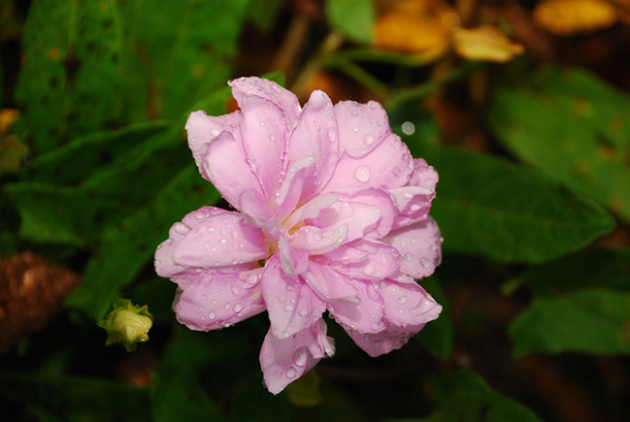
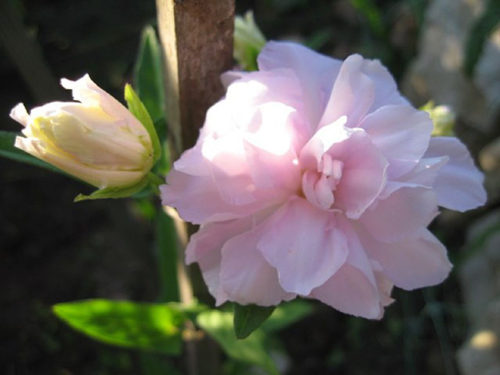
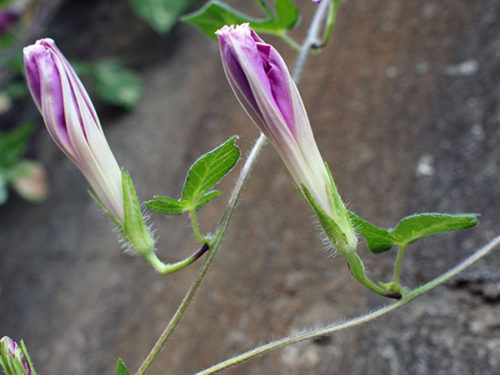
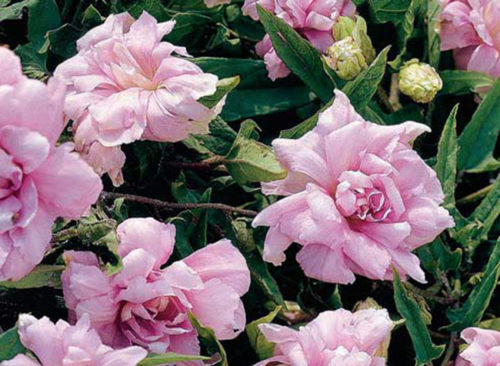
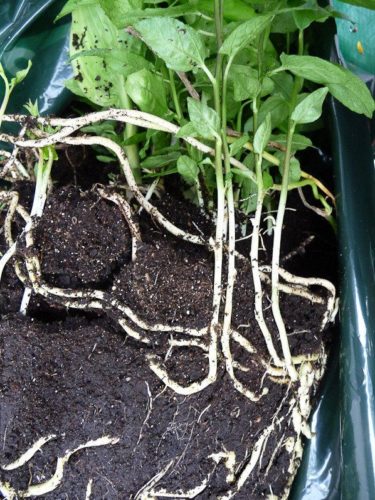
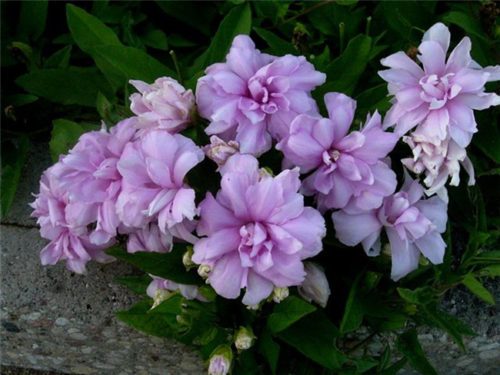
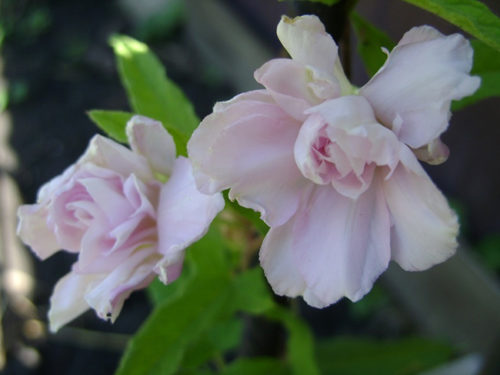

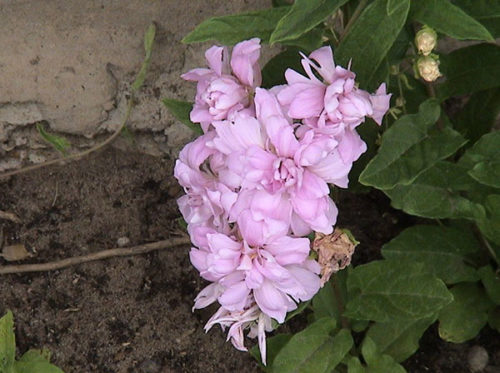
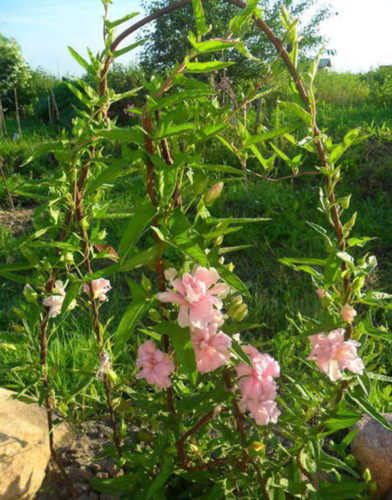
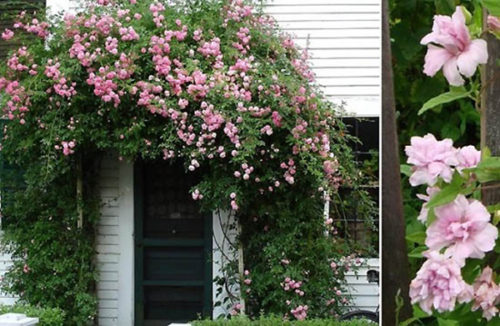
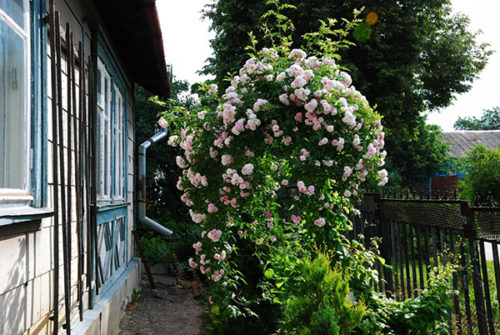
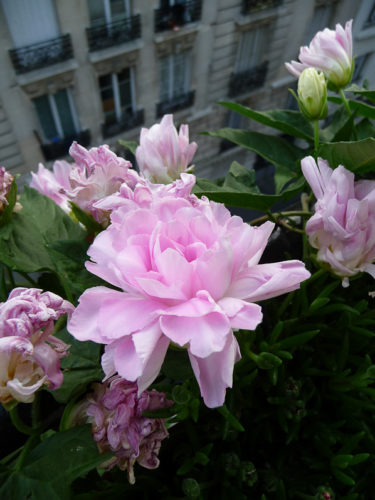
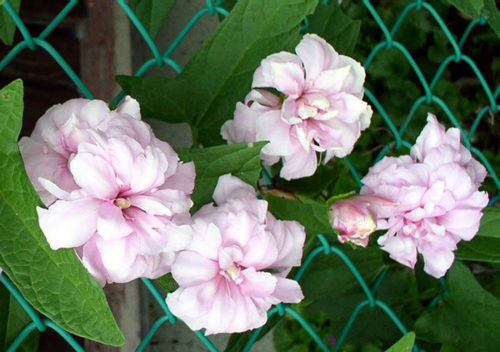
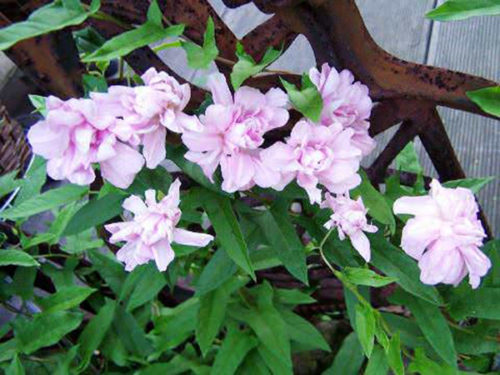












 Start a discussion ...
Start a discussion ...